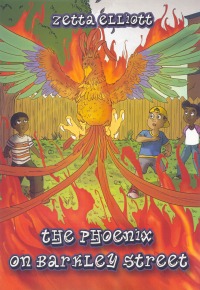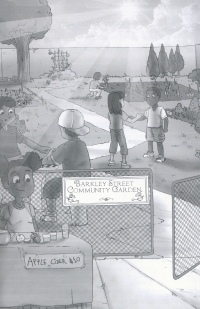| ________________
CM . . . . Volume XXI Number 13 . . . . November 28, 2014
excerpt:
When Tariq's best friend, Carlos, shows him a hidden way into an abandoned yard, the two boys are sure they've found the perfect place for a secret hang-out. The park at the end of Barkley Street is no longer an option: older boys, maybe even gang members, have claimed the park for themselves. Tariq and Carlos clean out the garbage and hack back the long grass. However, their secret isn't secret for long; when the two find a mysterious bird, they allow in Vikram, a classmate who knows a lot about dinosaurs and birds; and Tariq's younger sister, Zaria, and her best friend, Lisette, intrude. Tariq resents his sister's presence, but a physical fight is stopped by the bird, a phoenix. However, Tariq and his friends have a bigger problem when boys from the Python gang wreck their newly-tidied hang-out. An even bigger, more deadly fight begins and is stopped by the burning phoenix. After that day, the phoenix is gone, but Barkley Street is renewed as the residents band together to remove graffiti and turn the abandoned yard into a community garden.
The illustrations are black-and-white. The cheerful cartoon style depicts the phoenix almost as a buffoon, physically, which contradicts the text's emphasis on its beauty. The illustrations do not add significantly to the story as they repeat the text visually without adding nuance or perspective. The prose is repetitive. The phoenix, for example, is frequently described as "the strange bird" or "the golden bird," or "the strange golden bird" (on occasion, "huge," "huge golden," "mysterious," and "beautiful" are used instead); supporting details are not provided. Rashid's disappearance from the story after his humiliation and defeat by the phoenix is not a very realistic depiction of gang leader behaviour. There are also several places where the immediacy of the story is compromised: several events are told, rather than shown. However, countering these weaknesses is the text's empowerment of children's work, both as independent agents who borrow tools and voluntarily engage in physical labour to fix up the yard, and as part of a community, as the adult community's decision to clean up the neighbourhood and create a community garden is implicitly caused by the children's actions. The phoenix is not the cause of the revival and reclamation of Barkley Street, but it assists and guides the children and ultimately leaves them to continue what they have begun on their own initiative. Recommended. Janet Eastwood recently defended her master's thesis at the University of British Columbia. Copyright © the Manitoba Library Association. Reproduction for personal use is permitted only if this copyright notice is maintained. Any other reproduction is prohibited without permission.
Next Review |
Table of Contents for This Issue
- November 28, 2014. |

 Specific ages are not given for the characters, but Tariq, Carlos, and Vikram look no more than 12 (seventh grade) in the illustrations, which is supported by their class trip to a museum. The Pythons are teenagers while Zaria and Lisette look between eight and ten-years-old. The plot is linear and told from Tariq's perspective. The story is set in a contemporary, unnamed city in an area that is becoming a ghetto as families move away and gangs move in among abandoned buildings covered with graffiti, and physical violence is a fact of life. Tariq and Zaria initiate violence, albeit low-key violence such as shoving, as do their friends; Rashid, the leader of the Pythons, uses a broken glass as a weapon against the children. Arguments are commonplace, particularly between Tariq and Zaria, and are not resolved so much as forgotten from one day to the next.
Specific ages are not given for the characters, but Tariq, Carlos, and Vikram look no more than 12 (seventh grade) in the illustrations, which is supported by their class trip to a museum. The Pythons are teenagers while Zaria and Lisette look between eight and ten-years-old. The plot is linear and told from Tariq's perspective. The story is set in a contemporary, unnamed city in an area that is becoming a ghetto as families move away and gangs move in among abandoned buildings covered with graffiti, and physical violence is a fact of life. Tariq and Zaria initiate violence, albeit low-key violence such as shoving, as do their friends; Rashid, the leader of the Pythons, uses a broken glass as a weapon against the children. Arguments are commonplace, particularly between Tariq and Zaria, and are not resolved so much as forgotten from one day to the next.